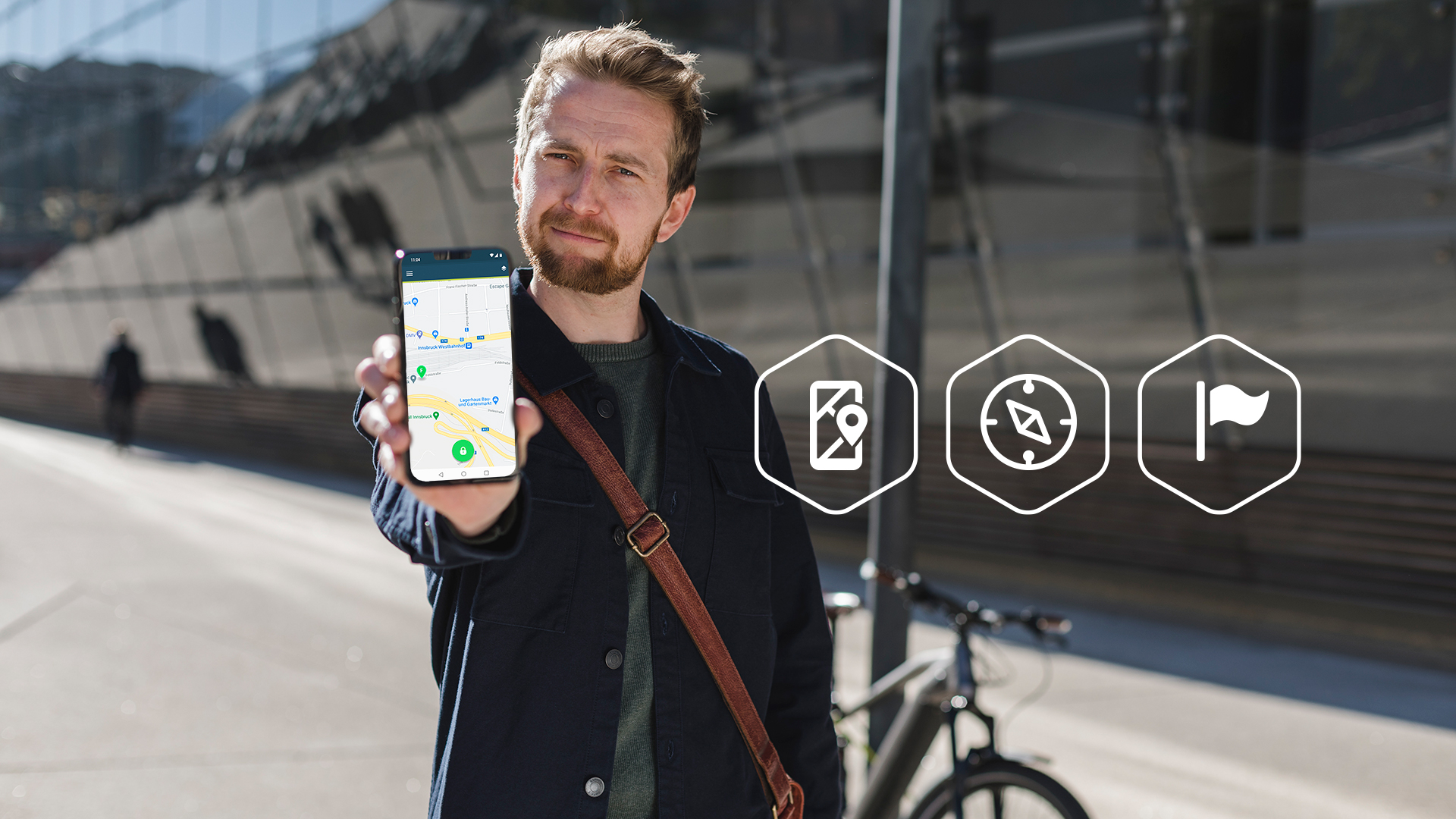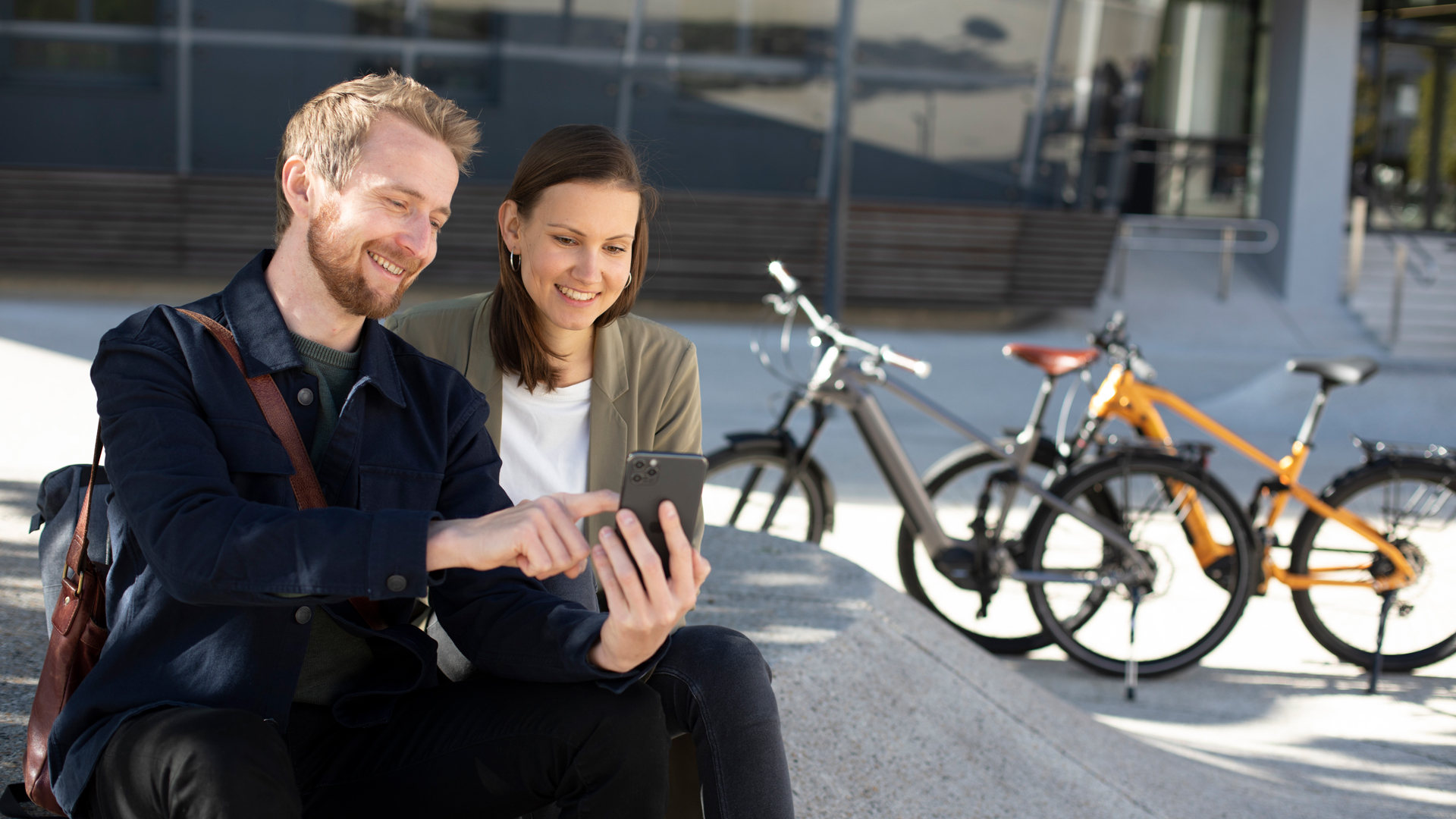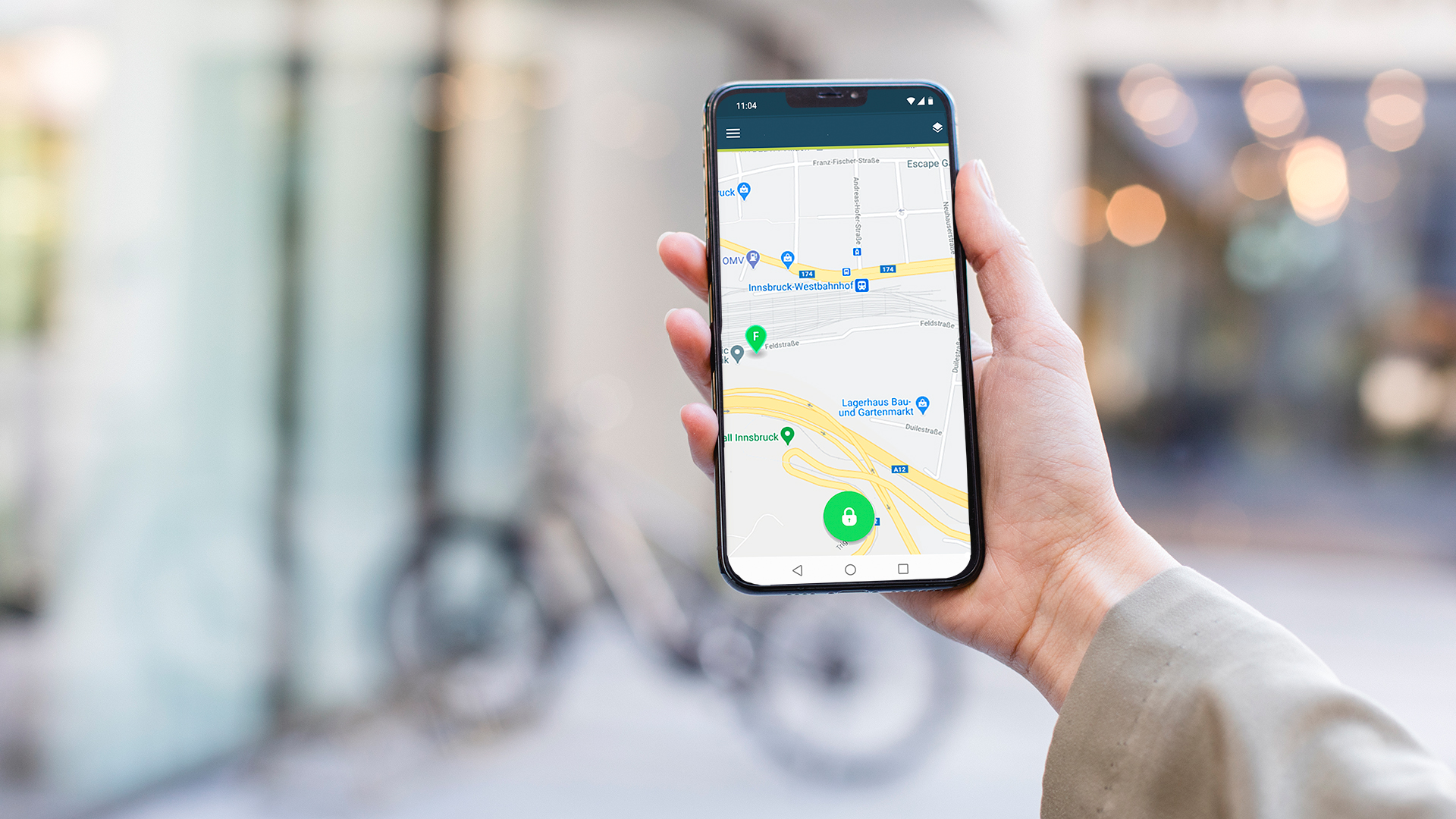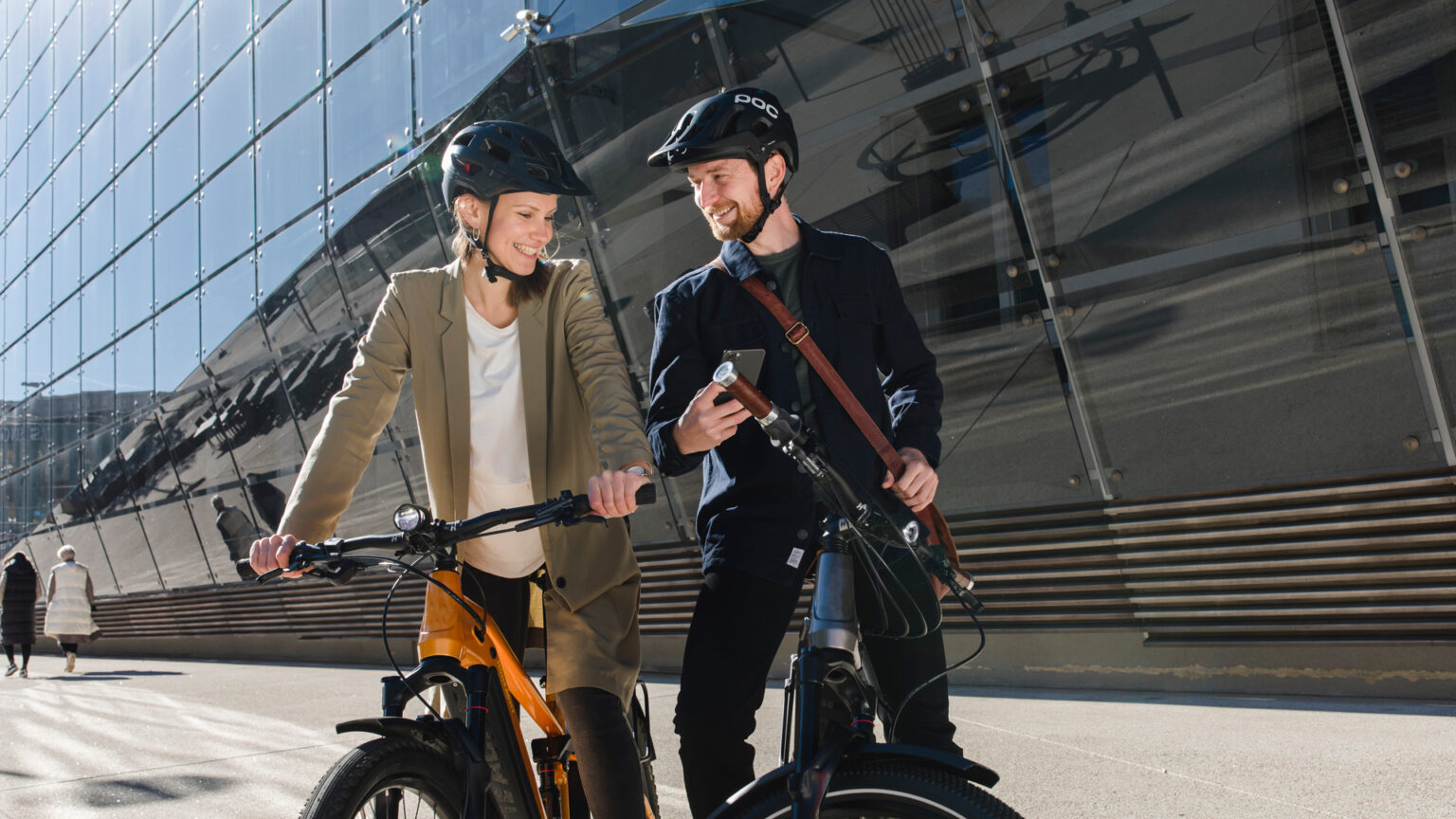- Free shipping from 220€The order of accessories (without BikeTrax) is excluded from the free shipping costs.
PowUnity explains, Top, Topics
E-bike navigation app – this is how smart e-bike navigation works
Inhalt
About e-bike navigation apps in a nutshell:
- There are no e-bike navigation apps for e-bikers, which is why e-bikers still use conventional bike navigation apps or motor apps with navigation function.
- Good usability, the use of offline maps, a free basic tariff for basic functions is indispensable for navigation apps. Features such as information about charging stations for e-bikes make navigation apps even more attractive.
- In our opinion, the ideal smart bike navigation app for e-bikes should coordinate navigation and battery status or adjust the support levels to the condition of the ground etc. or the time the biker wants to reach a destination.
- The PowUnity BikeTrax GPS tracker, together with the PowUnity app, is one of the leading e-bike theft protection solutions today and will cover e-bike control functions as well as bike navigation in the new PowUnity app in addition to the existing theft protection feature.
When it comes to a longer e-bike tour, a navigation app should be part of the basic equipment. However, e-bikers often have no choice but to use conventional bike apps or the navigation functions of e-bike apps (such as COBI.Bike from Bosch). And this is a pity, because a navigation app developed specifically for e-bikes could do much more.
We will explain what we mean by a smart e-bike navigation app and what added value it would have for e-bike riders in this article.
The state of the art – current bike apps for navigation
Bike computer with GPS vs. cycling apps for navigation
You may have asked yourself: why use a navigation app when I could also use a bike computer?
Of course, there is the option of using a bike computer with GPS for navigation. The advantage of this variant is that you don’t have to recharge the computer as it is automatically supplied with power by your electric bike.
However, the trend is moving towards the smartphone as the central control device. The main reasons for this are, for example, that most people already own a smartphone and that a mobile device is significantly more powerful than an average bike computer. In addition, smartphone often has a large, high-resolution display that is easy to read while riding and several solutions for charging your smartphone on your e-bike already exist. Thanks to these phone charging solutions, the annoying “battery empty problem” is no longer relevant.
Tip: You can find detailed information on why the smartphone is the better cycle computer in the long term in our article “Use phone as bike computer – why your smartphone is the best e-bike display”.
Good cycling apps for navigation – what makes them stand out?
There are many navigation apps aimed at cyclists, e-bike riders and even mountain bikers. Komoot is particularly well known, but apps like Bike Map or Bike Citizens with their in-app upgrades are also recommended. On the other hand, you will also find many cycling apps for navigation with a few reviews, that in practice deliver only a third of what they promise in theory. In fact, some of the other apps are more suitable for “anti-aggression training” rather than for cycling tours.
These are the central features in which apps for navigation differ:
- Usability: A pleasant usability and a clear menu are crucial for every navigation app. This is the only way you can concentrate on traffic and the road to get to your destination safely. With an additional voice feature, you don’t have to constantly look at the display.
- Offline maps: No internet, no navigation? With offline maps, internet access is not an issue. Whether offline navigation is possible and under what conditions differs greatly depending on the app or subscription model. Normally, free version is not enough and premium version is required.
- Costs: Many navigation apps for bikes and e-bikes have a free version. But they only become really useful if you pay a few euros – or more – for the premium version, which might provide you with more advanced routing options. In the long run, this is not necessarily as cheap as it seems at first. Therefore, a comparison is also worthwhile in this regard.
- Additional information: Whether sights, repair shops or charging stations, additional information about places along your route can be of great help.
You can find more tips and a selection of the best smartphone apps for e-bike owners, from tracking apps to fitness apps, in our article “The best bike apps 2021 and what makes them so special”.
Tip: A very interesting feature that the Cowboy company has added to its e-bike app is the display of the “cleanest route”. This means that the Cowboy app uses information on particulate matter pollution to show you the “healthiest route” through urban areas. If you often ride in big cities, you might appreciate this feature.
Differences between bike navigation apps and e-bike navigation apps
Leading cycling apps for navigation like Komoot are aimed at (almost) everyone: cyclists, e-bike riders, and mountain bikers. This has advantages. However, the special needs of e-bike riders are often neglected. If you want to change settings on your electric bike via your smartphone, you need another app and have to switch back and forth during the bike tour.
The situation is different with the COBI.Bike app from Bosch, for example. It combines navigation with the option of controlling the drive of your e-bike or switching the lights on and off. In terms of functionality, it is also one of the few examples of successful e-bike apps. However, since you need your own smartphone hub, this solution is relatively expensive.
But it is worth noting that even at Bosch, the navigation function itself is not specifically designed for e-bikes. What does this mean and how could it be improved? We’ll get to that in a moment.
The interaction of different data opens up new possibilities for e-bike navigation
For e-bike riders, other aspects play a central role in navigation than for riders of a conventional (mountain) bike. And the ideal cycling app for e-bike navigation should take these aspects into account.
Such aspects include the following, for example:
- Battery status: The battery status determines how long you can continue driving until it is time to head for the next charging station. Therefore, it makes sense to take it into account in a smart cycling app for navigation. We will explain how this would be possible later on.
- Ride data: Depending on the condition of the ground, gradients and other local conditions, different support levels are necessary. These support levels in turn have an effect on the battery charge level – similar to the speed sensors and driving behaviour of a car.
- Interaction of navigation and performance data: Perhaps the greatest potential of a special e-bike navigation app lies in bringing together the GPS data for navigation with the performance data collected via the e-bike. Then, for example, an app can answer the question of whether you can reach a destination with your current state of charge and which support levels are recommended or which you should do without. You can also have different route options (including the most efficient route) displayed depending on the battery capacity.
As you can see, the focus is on using synergy effects and bringing together ride and app data in a networked environment. In this area in particular, fascinating new possibilities – not only, but also for navigation – arise from the motorisation of bikes and their integration to the internet.
Important note: Only with the right e-bike apps you can fully benefit from the possibilities of your e-bike, regardless of whether you use it primarily as a means of transport in everyday life or as a piece of sports equipment. If you read our article “How to find the best e-bike app for your needs”, you will find out what distinguishes e-bike apps, what sets them apart from normal bike apps and how you can make the most out of them.
Excursion: All services in one PowUnity e-bike app
PowUnity has been working on the topic of e-bike connectivity and apps for years. The PowUnity BikeTrax GPS tracker, together with the PowUnity app, is one of the leading e-bike theft protection solutions today.
The PowUnity app user benefits from a complete, automatic route recording and can track his e-bike live throughout Europe.
2022 PowUnity is taking its connected e-bike product to the next level with an enhanced PowUnity e-bike app – for the benefit of BikeTrax users and e-bike manufacturers alike,
With this app, BikeTrax users will not only be able to protect their e-bike from theft, but also use their smartphone as an e-bike display. This is where all services come together – from e-bike control to bike navigation to an automatic maintenance and service plan and much more. The possible connection of the PowUnity BikeTrax GPS tracker to the CAN bus of the e-bike also allows further control functions of the e-bike to be set via the app.
We offer e-bike manufacturers a white-label solution of the PowUnity e-bike app, including a dashboard that shows the use of their e-bikes in various parameters.
Smart navigation in detail – this is what it could look like
In the following section, we will explain in concrete terms what an innovative navigation system for e-bikes should be able to do and what challenges arise.
Dynamic range indicator
We have already touched on this: The battery or its charge level has a considerable influence on navigation.
It is important to note that the range of a battery does not depend solely on how full it is. Instead, the following factors play a role:
- one’s body weight
- the driving style
- the surroundings
If you ride uphill a lot, your e-bike will need more power than if you drift downhill or follow bike lanes on a flat road. Whether you are riding on asphalt or gravel and whether you select the Turbo- or Eco-mode on your e-bike also plays a role. Even the direction from which the wind comes is an influencing factor.
This means that a general statement about how many kilometres a battery will last cannot be made. E-bikes (among others) share this dilemma with e-cars. In the latter case, one attempted solution is the “dynamic range indicator”. An algorithm calculates the actual range of the car based on various influencing factors – or at least tries to because at the moment, the result is often inaccurate.
For e-bike navigation systems, this means that smart navigation apps should include the battery level and other influencing factors in the calculation of the range, in the same way as the dynamic range display in e-cars. Of course, this also has its limits. Whether it will ever be possible to take the direction from which the wind blows into account in GPS navigation is somehow questionable.
Smart route navigation
Based on a dynamic range indicator, smart route navigation becomes possible.
The result could look like this:
- You enter your destination into your e-bike app.
- The app then calculates the optimal route that you can take with your current battery charge. It takes into account factors such as the ground conditions, your personal weight or the gradient.
- It may show you several routes, each of which is possible in a different mode – i.e. route A only in Eco-mode and route B also in Turbo-mode. This way you have the choice depending on how fast you want to get to your destination and how “sporty” you want your ride to be.
The advantages of such smart navigation:
Whether you’re running errands in the city, going to a meeting or on a longer outdoor bike tour, you know whether you’ll reach your destination with your current charge level.
You will also receive recommendations for the right riding style or the ideal support mode.
You won’t be unexpectedly confronted with an empty battery. For instance with Google Maps, you are likely come across such situation.
Of course, the prerequisite is that the algorithm of such an application is highly developed and accurate. Otherwise, you run the risk of relying on false promises and getting an unpleasant surprise during your ride.
Integration and consideration of public infrastructure
Finally, there is another valuable feature of smart navigation apps for e-bike owners. After all, every e-bike battery will run out at some point, no matter how well a dynamic range indicator works.
In this case, you benefit if your e-bike app shows you the nearest public charging options. Ideally, these are integrated into the map and, if necessary, already defined as a stopover.
However, there are two problems in connection with charging on the road:
- Currently, there are still few charging stations in most European countries.
- Charging an e-bike takes a relatively long time. Taking a quick breath for 5 minutes, stretching and then riding on is unfortunately not an option. The stopover has to be longer. Sometimes this is a welcome opportunity for a meal break, but in other situations it is a nuisance.
Fortunately, it is not only the network of charging stations that is being expanded. There are also initial solutions to the problem of longer charging times: One of them is battery exchange stations.
For example, the green tech start-up Swobbee and the e-mobility provider Urban Drivestyle enable customers to change the batteries of certain e-bikes at Swobbee stations as part of the “Berlin Bike Booster” campaign.
The advantage of this is that instead of taking a long time to charge the battery, you change it and can continue riding directly.
Although this is still a pilot project, battery replacement at charging stations may become standard in the future.
Tip: You can find detailed information on how to charge an e-bike on the road and where and how to find charging stations in our article “Finding an e-bike charging station: keep your e-bike fully functional”.
Smart navigation and route planning must be sophisticated
Smart navigation for e-bikes has great potential. However, this can only be realised if the live tracking of your tracking app is seamless and you can fully rely on it.
Average temporary solutions are no real help. On the contrary, they bring with them the risk that you will rely on incorrect information and that an empty battery “thwarts” your plans during your bike tour. Before you take this risk, it is better to rely on a conventional bike navigation app with offline maps and your own assessment. Well-known apps like Komoot are available for download for Android and iOS. Experienced e-bike riders often have a good sense of which routes they can handle and how.
However, once there are charging stations nationwide in the near future, a sophisticated e-bike app for the perfect route will be better than any gut feeling – or any GPS bike computer.
Share article!








 Deutsch
Deutsch